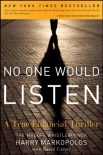No One Would Listen: A True Financial Thriller by Harry Markopolos (rainbow fish read aloud .txt) 📗

- Author: Harry Markopolos
Book online «No One Would Listen: A True Financial Thriller by Harry Markopolos (rainbow fish read aloud .txt) 📗». Author Harry Markopolos
These same skeptics speculate that at least part of the returns must come from other activities related to Madoff’s market making. They suggest, for example, that the bid-ask spreads earned through those activities may at times be used to “subsidize” the funds.
According to this view, the benefit to Madoff Securities is that the capital provided by the funds could be used by the firm as “pseudo equity,” allowing it either to use a great deal of leverage without taking on debt, or simply to conduct far more market making by purchasing additional order flow than it would otherwise be able to do.
And even among the four or five professionals who both express an understanding of the strategy and have little trouble accepting the reported returns it has generated, a majority still expresses the belief that, if nothing else, Madoff must be using other stocks and options rather than only those in the S&P 100.
Bernie Madoff is willing to answer each of those inquiries, even if he refuses to provide details about the trading strategy he considers proprietary information.
And in a face-to-face interview and several telephone interviews, Madoff sounds and appears genuinely amused by the interest and attention aimed at an asset management strategy designed to generate conservative, low risk returns that he notes are nowhere near the top results of well-known fund managers on an absolute return basis.
Lack of Volatility Illusory
The apparent lack of volatility in the performance of the fund, Madoff says, is an illusion based on a review of the monthly and annual returns. On an intraday, intraweek and intramonth basis, he says, “the volatility is all over the place,” with the fund down by as much as 1 percent.
But as a whole, the split-strike conversion strategy is designed to work best in bull markets and, Madoff points out, until recently “we’ve really been in a bull market since ’82, so this has been a good period to do this kind of stuff.”
Market volatility, moreover, is the strategy’s friend, says Madoff, as one of the fundamental ideas is to exercise the calls when the market spikes, which with the right stock picks would add to the performance.
In the current bearish environment, when some market experts think the fund should have been showing negative returns, albeit at levels below the benchmark index, managing the strategy has become more difficult, says Madoff, although performance has remained positive or, as in February, flat.
The worst market to operate in using the strategy, he adds, would be a protracted bear market or “a flat, dull market.” In a stock market environment similar to what was experienced in the 1970s, for instance, the strategy would be lucky to return “T-bill like returns.”
Market timing and stock picking are both important for the strategy to work, and to those who express astonishment at the firm’s ability in those areas, Madoff points to long experience, excellent technology that provides superb and low-cost execution capabilities, good proprietary stock and options pricing models, well-established infrastructure, market making ability and market intelligence derived from the massive amount of order flow it handles each day.
The strategy and trading, he says, are done mostly by signals from a proprietary “black box” system that allows for human intervention to take into account the “gut feel” of the firm’s professionals. “I don’t want to get on an airplane without a pilot in the seat,” says Madoff. “I only trust the autopilot so much.”
As for the specifics of how the firm manages risk and limits the market impact of moving so much capital in and out of positions, Madoff responds first by saying, “I’m not interested in educating the world on our strategy, and I won’t get into the nuances of how we manage risk.” He reiterates the undisputed strengths and advantages the firm’s operations provide that make it possible.
Multiple Stock Baskets
Avoiding market impact by trading the underlying securities, he says, is one of the strategy’s primary goals. This is done by creating a variety of stock baskets, sometimes as many as a dozen, with different weightings that allow positions to be taken or unwound slowly over a one- or two-week period.
Madoff says the baskets comprise the most highly capitalized liquid securities in the market, making the entry and exit strategies easier to manage.
He also stresses that the assets used for the strategy are often invested in Treasury securities as the firm waits for specific market opportunities. He won’t reveal how much capital is required to be deployed at any given time to maintain the strategy’s return characteristics, but does say that “the goal is to be 100 percent invested.”
The inability of other firms to duplicate his firm’s success with the strategy, says Madoff, is attributable, again, to its highly regarded operational infrastructure. He notes that one could make the same observation about many businesses, including market making firms.
Many major Wall Street broker-dealers, he observes, previously attempted to replicate established market making operations but gave up trying when they realized how difficult it was to do so successfully, opting instead to acquire them for hefty sums.
[Indeed, says Madoff, the firm itself has received numerous buyout offers but has so far refused any entreaties because he and the many members of his immediate and extended family who work there continue to enjoy what they do and the independence it allows and have no desire to work for someone else.]
Similarly, he adds, another firm could duplicate the strategy in an attempt to get similar results,





Comments (0)